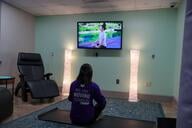You have /5 articles left.
Sign up for a free account or log in.

Paul Bradbury/OJO Images/Getty Images
As students left higher education in droves during the pandemic, 25 colleges and universities launched campaigns to re-enroll them ahead of fall 2021, in partnership with InsideTrack, a nonprofit that helps institutions enroll students and improve academic outcomes through coaching. The campaigns yielded positive results, according to preliminary data released by InsideTrack today.
Partner colleges and universities ultimately reached out to 27,000 students who stopped out during the pandemic. About 73 percent of those students were students of color, first-generation students, low-income students or older adult learners. Success coaches were able to re-enroll 3,000 students for the summer and fall 2021 semesters.
The 25 partner institutions included eight community colleges, four public universities and three private, nonprofit institutions. A cohort of eight historically Black colleges and universities and one predominantly Black institution also participated as part of a pilot program launched by the United Negro College Fund. These campaigns to re-engage former students follow staggering enrollment declines at colleges and universities across the country—undergraduate enrollment nationwide fell 6.6 percent between fall 2019 and fall 2021, a loss of more than a million students, according to recent data from the National Student Clearinghouse Research Center.
Ruth Bauer White, president of InsideTrack, described re-enrollment efforts as a critical part of the country’s economic recovery and “equitable social mobility” after the pandemic.
“Over the last two years in the pandemic, so many people have left school and have left education because they had to for many reasons, whether it was financial, their own well-being, feeling pulled in many directions, having to stay at home to take care of their own children,” she said. “For us to kind of recover from the last couple of years, part of that is getting folks back on track to achieve their goals and focus on the future and have hope.”
As a part of the re-enrollment campaigns, InsideTrack coaches called, emailed and texted students identified by the colleges as having left college over the last two years to help them register for courses. Coaches prioritized connecting with students who had the fewest credits left to earn in order to graduate and who’d left college within the last two semesters. Once students responded, coaches also helped them set long-term academic and career goals; prepare for potential obstacles, such as balancing work and family responsibilities; and connect to on-campus resources, including financial aid, mental health services and academic supports.
The goal was to “really help students who may not have that system of support that provides guidance, encouragement, advice on how you navigate the path in the midst of so much uncertainty,” said Julian Thompson, director of strategy at UNCF’s Institute for Capacity Building, which guides institutions in raising admission, enrollment and graduation rates.
He noted that HBCU students are disproportionately first-generation students who especially benefit from comprehensive coaching. Nearly 40 percent of those attending HBCUs are first-generation college students, according to a 2021 UNCF report.
As a part of the UNCF campaign, coaches contacted 4,000 students who stopped out. UNCF leaders hoped 4 percent of those students would ultimately re-enroll with the help of the coaches, but the results surpassed their expectations. On average, 8.6 percent of students contacted by success coaches at each institution—and 38 percent of students who responded to the outreach—registered for classes, a total of 344 students across institutions.
Because of the campaign’s success, UNCF plans to expand the pilot program to include more institutions and provide “retention coaching” for students throughout the first year of their re-enrollment.
Data from InsideTrack also suggest the re-enrollment campaigns could have a 275 percent return on investment for institutions. The organization reported that coaching students costs $603 on average for each student re-enrolled, but collectively, the increased enrollment at the institutions after students complete one semester generates an estimated $5.9 million in tuition revenue, according to the organization.
White noted that college leaders know it’s crucial to re-engage students who left but often lack the “bandwidth” to contact them one by one and individually coach them through the re-enrollment process, especially during a pandemic that’s left higher education institutions “stretched thin” as they seek to address a wide variety of student needs.
Howard Gibson, vice president of academic affairs at Wiley College in Texas, which participated in the pilot program, said that was the case for his institution. For example, he noted that academic coaches focused on first-time freshmen and sophomores each have a caseload of at least 80 students.
The “manpower” offered by the partnership with InsideTrack allowed for a “microscopic focus” on each student who wanted to re-enroll, he said. And the feedback students gave coaches about the barriers that led them to drop out “allows us to streamline our processes, to refocus, to reimagine what we’re doing, not just for that student but for all our students … Extra hands, extra assistance goes a long way.”
Enrollment at Wiley dwindled from 726 students in spring 2020 to 501 students in spring 2021, as students struggled with the spread of COVID-19 infections, an abrupt shift to online learning and financial hardships associated with the pandemic. Enrollment rose back up to 665 students in fall 2021, and Gibson partly credits the coaches. Through the InsideTrack partnership, 49 students who stopped out re-enrolled in fall 2021, and 24 re-enrolled this spring.
Laura Leatherwood, president of Blue Ridge Community College in North Carolina, also one of the participating institutions, said the re-enrollment efforts are a critical way to reach adult learners in particular.
“Re-engaging former students must be a foundational part of our strategy for ensuring that working adults can attain the skills and credentials they need to succeed in an increasingly fast-changing economy and labor market,” Leatherwood said in a press release. “It’s about creating the sort of scaffolding and support that can enable returning students to successfully re-enroll, complete their studies and prepare for highly skilled—and higher-paying—careers.”
Mamie Voight, president and CEO of the Institute for Higher Education Policy, said efforts to re-enroll students have proliferated at higher ed institutions across the country, and “rightfully so.”
She cited the 36 million students in the United States who have attended some college but never graduated, noting that they’re “disproportionately first-generation students, students from low-income backgrounds, Black and Latinx students, underrepresented Asian American/Pacific Islander students” and “students who have historically been underserved by our higher education system.” Efforts to re-enroll students have “really strong equity implications” for the country, she said.
IHEP is currently working with about 200 colleges and universities in 23 states to examine student transcripts and identify students who left college “just shy” of earning the credits they needed to graduate. The organization also helps colleges find students who already have enough credits to graduate but never did because of various barriers, such as an unpaid balance or fine or a missing graduation form. The initiative, called Degrees When Due, also helps colleges address the barriers and practices that most commonly prevent students from graduating.
“The bottom line: we know that institutions need to be intentional in the ways in which they re-engage stopped-out students,” Voight said.
Jennifer Freeman, a senior director at Jobs for the Future, emphasized that career advising in particular is crucial to successfully re-engaging students. She said students want to return to college with the assurance that their credentials will lead to good-paying job opportunities, and she believes that’s reflected in increased interest in workforce credentials. For example, she noted that the North Carolina Community College System experienced a 22 percent increase in enrollment in short-term workforce education in fall 2021.
Campaigns to re-enroll students need to “really convey to people that what they’re going to get when they come back to college is a road to economic success and have a very, very clear line to a labor market outcome for them,” she said. She stressed that colleges then need to deliver on that promise, providing students with programs designed to fill workforce needs that offer flexibility for working adults with other responsibilities and make them more likely to complete college.
White said she believes her organization’s re-enrollment campaigns can have a multigenerational ripple effect by helping students—who would otherwise hold student loan debt with no degree—graduate and earn higher wages.
“By coming back to school, they’re reaching their goal, a college education, and then they are ensuring that they can then utilize that degree in order to convert it into social mobility and into a promotion, the next job opportunity,” she said. “And that has a significant impact on their family, on their community, on society as a whole and allows them to see that return on investment that they made, both in money and in time for their education and not have that go to waste.”





